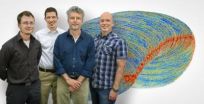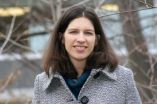(Press-News.org) ITHACA, N.Y. — With a dizzying number of ties in our social networks – that your Aunt Alice is a neighbor of Muhammad who is married to Natasha who is your wife's boss – it's a wonder we remember any of it. How do we keep track of the complexity? We cheat, says a Cornell University sociologist in Scientific Reports (March 21), a publication of Nature.
Study: http://www.nature.com/srep/2013/130321/srep01513/full/srep01513.html
Humans keep track of social information not by rote memorization but with simplifying rules, as you might remember a number sequence that always increases by two, according to author Matthew Brashears, assistant professor of sociology. People recall social ties that both involve at least three people who know each other and kinship labels such as "aunt" twice as well as they remember ties that do not, even though triad kinship networks are far more complex, he said.
"Humans are able to manage big, sprawling, complicated social networks essentially because we don't remember big, sprawling, complicated social networks. We remember simplified, regular structures that bear a reasonable similarity to what those networks look like," Brashears said. In cases where the relationships don't fit the pattern, we remember the pattern and the few exceptions, instead of remembering all the ties simultaneously, he added.
About 300 study participants read paragraphs describing a group of people and how they relate to each other. Some paragraphs included kinship labels and some didn't. Other paragraphs included closed triads – where three people each know each other – while other paragraphs did not. The participants were then asked to recall as many of the ties as possible.
When the paragraphs contained both kinship labels and closed triads, the participants' recall improved by 50 percent compared with participants whose paragraphs included neither – even though the kinship and triad paragraphs contained nearly twice as many relationships.
"That's a pretty substantial improvement," Brashears said. Moreover, participants did worse when trying to recall paragraphs that had kin relationships but no triads. "It's like trying to remember a random number sequence by using the 'increase by two' rule," he said.
The study helps explain how humans actively manage so many more social ties compared with other primates – a key question in the field of sociology. The answer is that we evolved the capacity to spot and use social patterns.
"Our ability to remember and manage socials ties – and build bigger groups of people – had to do with coming up with new and interesting ways of compressing that information. It's about how we structure our groups and how that allows us to remember them, as opposed to just sheer cognitive horsepower," he said.
The research may help also explain some peculiarities of human networks, such as transitivity: If George is my friend and Susan is my friend, then Susan and George are likely to be friends. Brashears suspects that some social networks are easier to remember than others, and individuals who build groups that conform to those rules were more evolutionarily successful.
"Some of the reasons why human networks look the way they do is because they have to, in order for us to process them, to manage it cognitively," he says.
Medical researchers may benefit from the research as they seek to understand why some people don't grasp social intricacies as well as others. "We may have a better ability to understand social anxiety and autism spectrum if we understand how we're compressing and reconstructing social information using these mechanisms," Brashears said.
###
Cornell and the National Science Foundation funded the research.
Contact Syl Kacapyr for information about Cornell's TV and radio studios.
Do I know you? Memory patterns help us recall the social webs we weave, finds new Cornell study
2013-03-21
ELSE PRESS RELEASES FROM THIS DATE:
Genetic risk strategies needed for young, black, female breast cancer patients, Moffitt study shows
2013-03-21
Researchers at Moffitt Cancer Center and colleagues in Canada have published study results focused on black women younger than 50, a population disproportionately afflicted with and dying from early-onset breast cancer compared to their white counterparts. The research published in the Jan. 16 issue of The Breast Journal.
Early-onset breast cancer has been associated with mutations in the BRCA1 and BRCA2 genes. These breast cancer predisposing genes were discovered almost 20 years ago and confer a lifetime risk of breast cancer of 60 to 70 percent, as well as a much higher ...
Berkeley Lab scientists read the cosmic writing on the wall
2013-03-21
Thanks to a supersensitive space telescope and some sophisticated supercomputing, scientists from the international Planck collaboration have made the closest reading yet of the most ancient story in our universe: the cosmic microwave background (CMB).
Today, the team released preliminary results based on the Planck observatory's first 15 months of data. Using supercomputers at the U.S. Department of Energy's (DOE) National Energy Research Scientific Computing Center (NERSC) Planck scientists have created the most detailed and accurate maps yet of the relic radiation ...
For the first time, recommendations offer guidance about incidental genetic findings
2013-03-21
Boston – In a highly anticipated report, landmark recommendations on the handling of incidental findings in clinical genome and exome sequencing are being issued from the American College of Medical Genetics and Genomics (ACMG). A report of the recommendations, led by Robert C. Green, MD, MPH, a medical geneticist at Brigham and Women's Hospital (BWH), outlines for the first time a minimum list of genetic conditions, genes and variants that laboratories performing clinical sequencing should seek and report to the physicians that ordered the testing -- regardless of the ...
European Guidance for the diagnosis & management of osteoporosis in postmenopausal women
2013-03-21
A new Guidance recently published by the European Society for Clinical and Economic Aspects of Osteoporosis (ESCEO) and the International Osteoporosis Foundation (IOF) reflects the most current advances in the diagnosis and management of osteoporosis, the 'silent disease' which affects up to one in two postmenopausal women.
"The serious impact of fragility fractures due to osteoporosis is vastly underestimated by many health care professionals," stated ESCEO President Professor Jean-Yves Reginster.
"Statistics clearly show that fragility fractures in older adults ...
Differences in bone healing in old mice may hold answers to better bone healing for seniors
2013-03-21
Philadelphia – By studying the underlying differences in gene expression during healing after a bone break in young versus aged mice, Jaimo Ahn, MD, PhD, assistant professor of Orthopaedic Surgery at the Perelman School of Medicine, University of Pennsylvania, and his colleagues aim to find specific pathways of fracture healing in humans. The team of researchers will present their findings in a poster presentation beginning Tuesday, March 19, 2013 at the 2013 American Academy of Orthopedic Surgeons annual meeting in Chicago.
Problems with healing after bone fractures ...
Microalgae could be a profitable source of biodiesel
2013-03-21
Researchers at the UAB's Institute of Environmental Science and Technology (ICTA-UAB) and the Institute of Marine Sciences (ICM-CSIC), have analysed the potential of different species of microalgae for producing biodiesel, comparing their growth, production of biomass and the quantity of lipids per cell (essential for obtaining fuel).
Their study shows that one type of marine algae that has received little attention till now - dinoflagellate microalgae - is highly suitable for cultivation with the aim of producing biodiesel.
The scientists carried out the whole production ...
Findings to help in design of drugs against virus causing childhood illnesses
2013-03-21
WEST LAFAYETTE, Ind. - New research findings may help scientists design drugs to treat a virus infection that causes potentially fatal brain swelling and paralysis in children.
The virus, called enterovirus 71, causes hand, foot and mouth disease and is common throughout the world. Although that disease usually is not fatal, the virus has been reported to cause fatal encephalitis in infants and young children, primarily in the Asia-Pacific region.
Currently, no cure exists for the infection.
New findings show the precise structure of the virus bound to a molecule that ...
Understanding the continuous corn yield penalty
2013-03-21
URBANA – As escalating corn prices have encouraged many farmers to switch to growing corn continuously, they wonder why they have been seeing unusually high yield reductions over the past several years. The University of Illinois conducted a six-year study that identified three key factors affecting yield in continuous corn (CC) systems.
"Prior to this study, the most common management recommendations for continuous corn production were to apply an additional 45 pounds of nitrogen per acre and reserve your best crop land for it," said U of I soil scientist and lead author ...
Park amenities differ according to income of neighborhoods
2013-03-21
COLUMBIA, Mo. – Every community in America has its share of parks. However, park amenities in certain communities can be lacking, which can be detrimental to the health of potential patrons. Now, a University of Missouri researcher has found that while more parks exist in lower-income neighborhoods, they tend to be less attractive than parks in upper- and middle-class neighborhoods, which have more amenities and are more visually pleasing.
"Parks are important for physical activity and socialization among community members," said Sonja Wilhelm Stanis, assistant professor ...
Planck's new map brings universe into focus
2013-03-21
The Planck space mission has today (March 21) released the most accurate and detailed map ever made of the oldest light in the universe. The universe according to Planck is expanding a bit more slowly than thought, and at 13.8 billion is 100 million years older than previously estimated. There is a bit less dark energy and a bit more of both normal and dark matter in the universe — although the nature of dark energy and dark matter remain mysterious.
"Planck's high-precision map of the oldest light in our universe allows us to extract the most refined values yet of the ...

